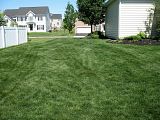I've updated my lawn photos (finally). This is just post-mowing, so you can see the robot's sort of random lines in the lawn. Color is good, but not quite perfect yet.
Click on any photo to see the larger version!
Here's my standard shot:
The front township damage from last year is finally closing off:
Here's a photo of the southern face and garden. The clematis looks pretty good, but I'm afraid the dogwood it's climbing up is a lost cause--it's probably Dogwood anthracnose fungus, which means the tree will die.
Thursday, May 13, 2010
Lawn Photos
Wednesday, May 12, 2010
Frost Damage
Regrettably, I lost all the Melampodium (fortunately, I only had 8). Temperatures last night dropped to 31, and I barely managed to hold off a frost. Melampodium is extremely unhappy even at 35. I purchased replacements for those today when I ran out for this year's heliotrope.
It also looks like a dozen or so marigolds were frost-burned in the northeastern garden. I'll need to replace those as well when I can go get the Janie marigolds.
It's a shame, but at least I only lost 20 plants out of 850 or so, and they're easy and cheap to replace.
On the up side, it looks like we're clear of frost for at least a week, by which time a frost becomes extremely unlikely!
Sunday, May 9, 2010
Frost Warning!
Surprisingly, most of us in Pennsylvania and areas northward are under a frost or freeze warning for tonight.
If you have tender annuals in already (I do), watering the gardens before dark, including the surrounding areas, will help limit the temperature drop and keep the frost off the plants. See "A Veil of Frost Protection," about 3 posts down, for more information.
Update: That reference above was a tease, and I hate teasing. Here's a reprint of the same information:
There are a few ways to protect gardens from an unexpected frost.
The most common is to cover the plants, which is not realistic in my case–there are too many, and in areas that are too large. With all the burlap I have on-hand, I might be able to cover 1/3 of the garden that’s at risk. Additionally, it must be promptly removed in the morning or the plants may end up baking under the covering.
In my case, I ran the watering systems on the grass for twenty minutes and the garden for the same. Raising the humidity to nearly 100% at 45 degrees makes temperature drops difficult. The dew point is higher, so as temperatures try to drop the water has to condense out of the air, releasing a large amount of heat and helping to protect the plants. Additionally, the condensed water settles on the plants and soil at the temperature at which it condensed, helping to stop further drops in temperature.
The veil of frost protection woven by applying water is delicate and can be overcome if temperatures fall under 32°, but most unseasonable frosts can be overcome this way.
Wednesday, May 5, 2010
Sub-Zero Rose
[caption id="attachment_261" align="alignleft" width="151" caption="Margaret Chase Smith Sub-Zero rose"] [/caption]
[/caption]
I planted a new Margaret Chase Smith Sub-Zero rose to replace the Double Knockout rose I lost over the winter. As it turns out, the bud union (the swelling at the bottom of the stem) should be planted 1" underground for Zone 6 and 2" underground for colder locations. I planted the Double Knockout's bud union at ground level or slightly above, in an area with intense winter winds.
Tuesday, May 4, 2010
Milk On The Lawn
I applied 4 ounces per thousand of whole milk (pasteurized and homogenized) today to test whether it enhances the soil and lawn quality.
Done with raw milk (straight from the cow) it seems to work. This will see if processed milk from the grocery store (cheap and easily available) is also an option.